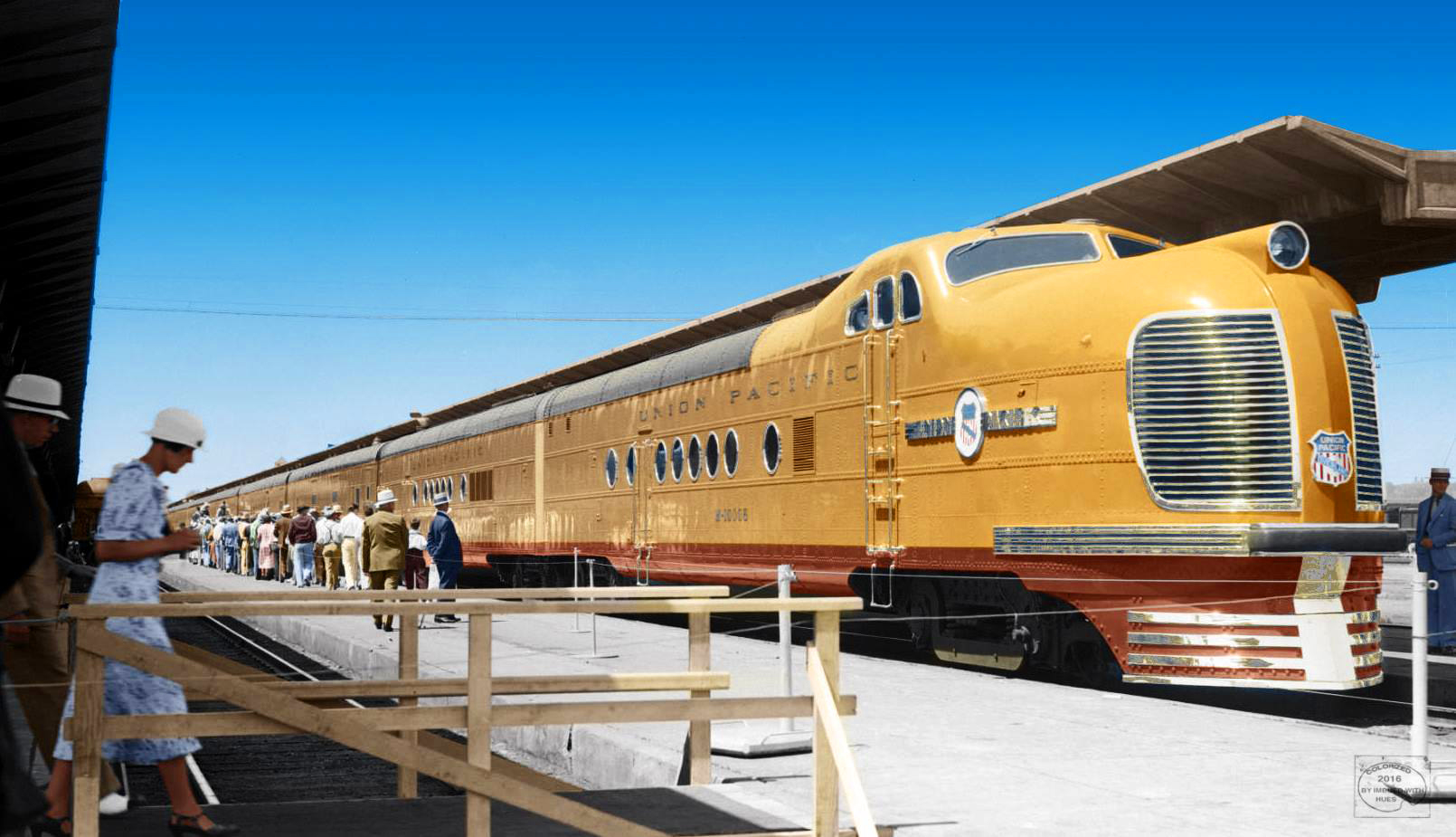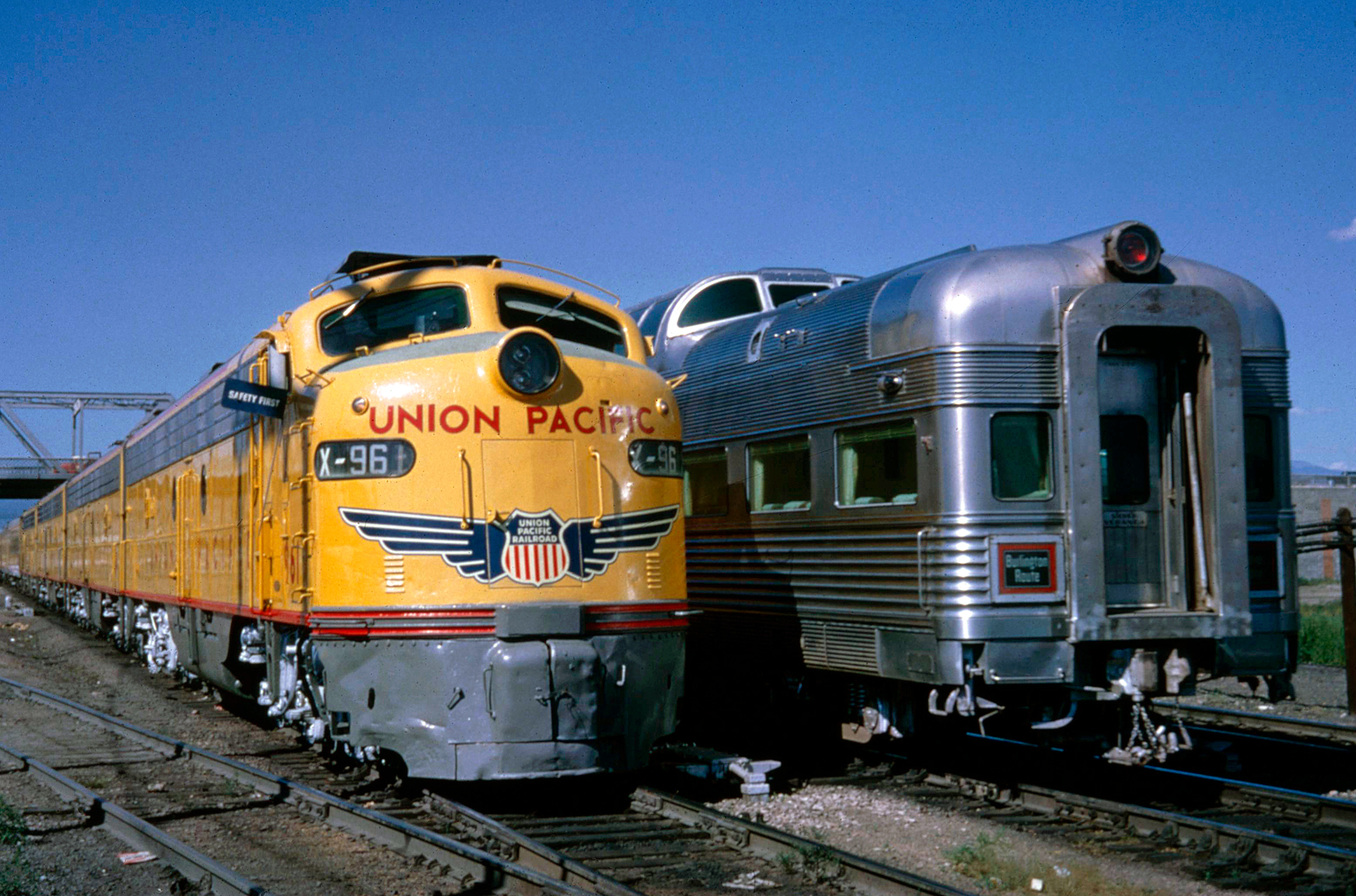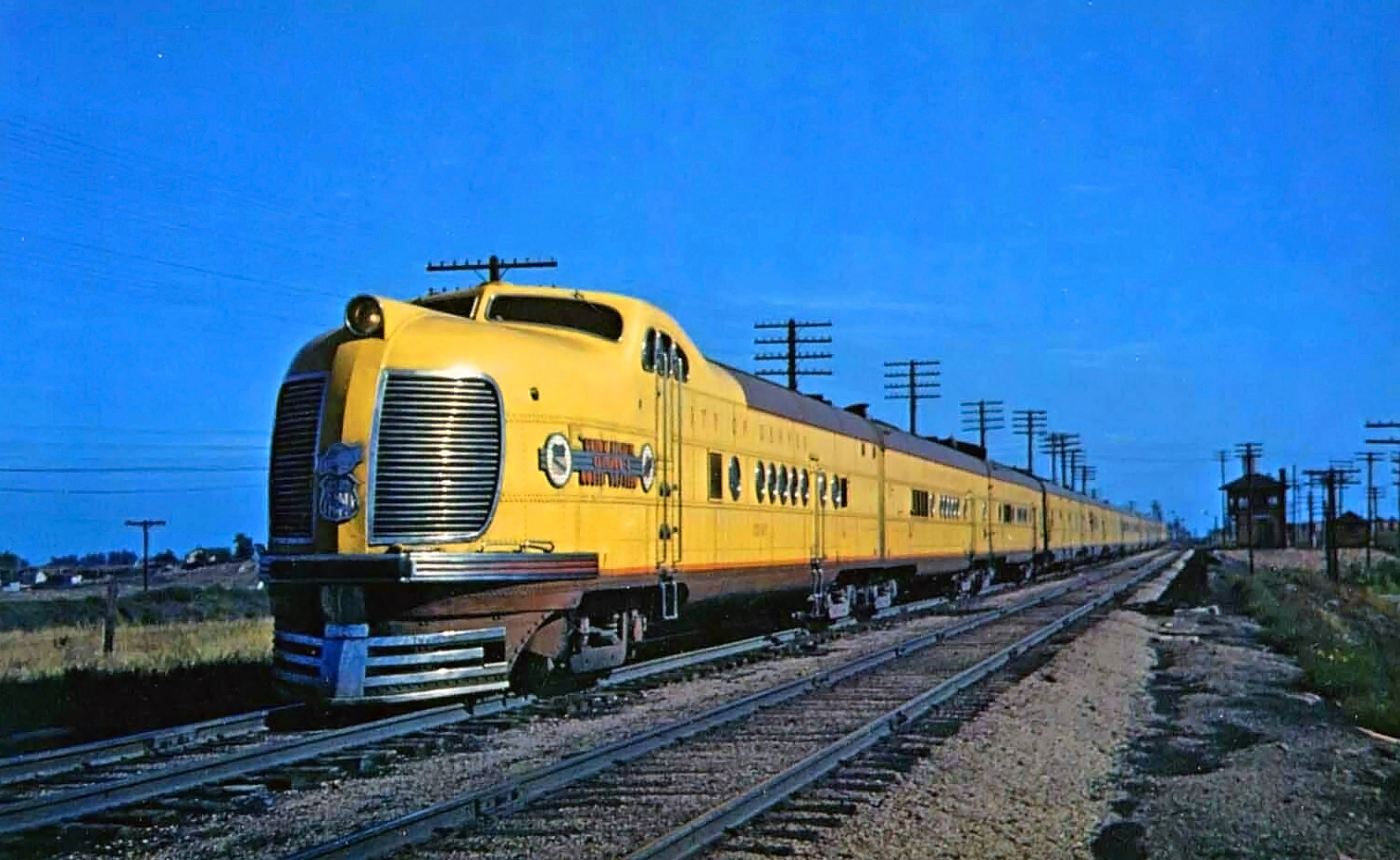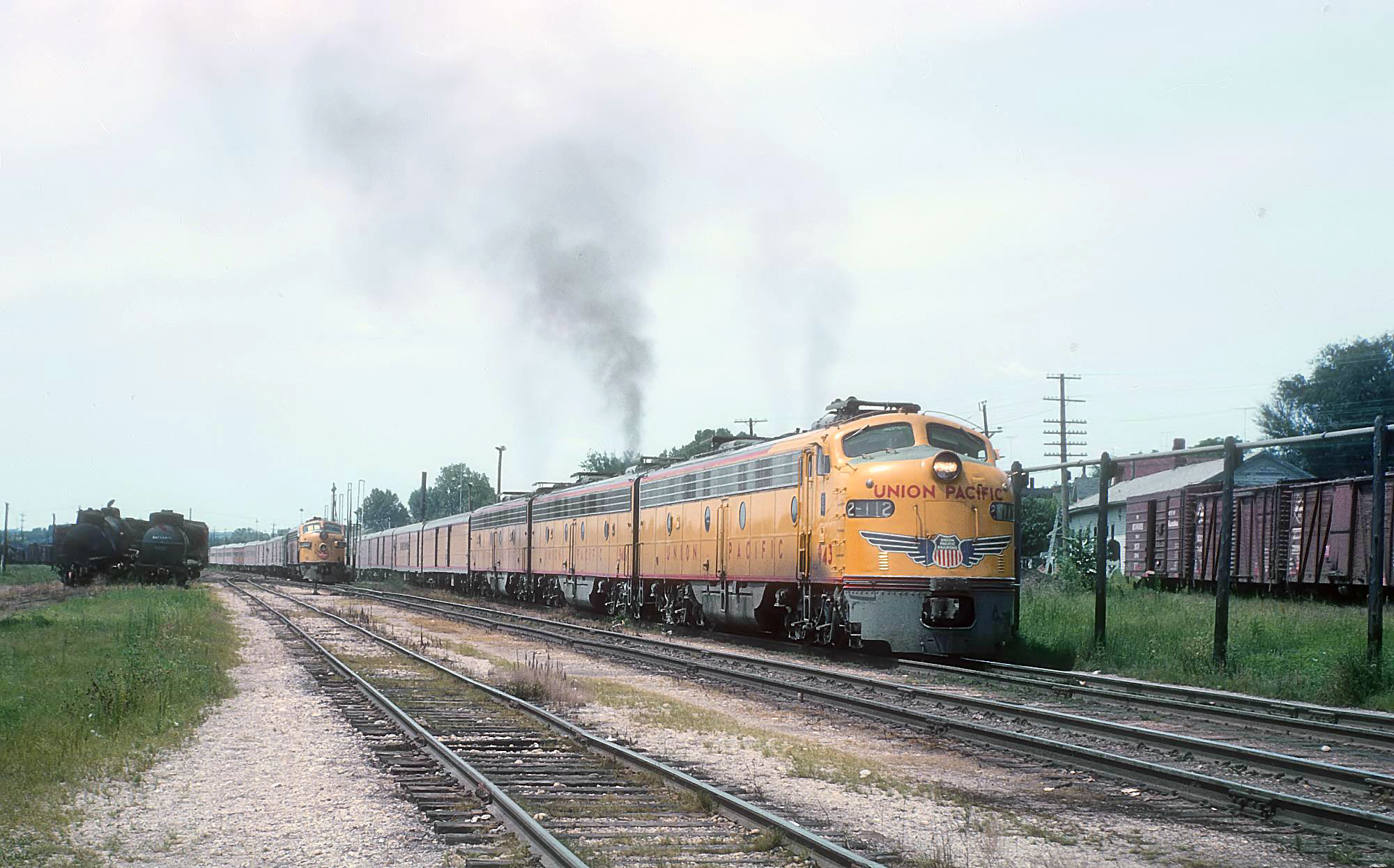The "City of Denver": The M-10005 Trainset
Last revised: August 25, 2024
By: Adam Burns
The City of Denver was just one train in the Union Pacific’s premier fleet of passenger trains. As one of the first streamliners released the Denver
was incredibly popular with the traveling public.
The UP would go on to host an entire array of other plush City trains including the City of Portland, City of Los Angeles, City of Salina, City of St. Louis, City of San Francisco, and City of Las Vegas.
Originally a joint operation with the Chicago & North Western, the Denver was quite successful and its name remained on UP's timetable until the startup of Amtrak.
Today, the City fleet can still be witnessed, in a manner of speaking, as the UP’s official business train is not only decorated in the Cities’ classic livery but also includes the original equipment from them, right down to the two E9As and E9Bs that power it!
Photos
 Union Pacific's M-10005, the "City Of Denver," sits on display at Denver Union Station on June 14, 1936 a few days before the new streamliner officially entered service (June 18th). Otto Perry photo/colorized by Patty Allison.
Union Pacific's M-10005, the "City Of Denver," sits on display at Denver Union Station on June 14, 1936 a few days before the new streamliner officially entered service (June 18th). Otto Perry photo/colorized by Patty Allison.History
Union Pacific, the largest and one of the most powerful railroads in the country, has been with us since 1862. The company is far older than any other American Class I railroad today with the Kansas City Southern in a nearby second.
In that time UP has become not only one of the most highly respected institutions in the nation but also has seen nearly every major railroading event in our country’s history, and accordingly has a very long and storied history.
M-10005
The original City of Denver took to the rails on June 18, 1936 as the railroad's M-10005 and M-10006 semi-articulated trainsets from the Electro-Motive Corporation (of which the railroad owned a total of seven).
These trainsets featured three baggage cars on the head-end (two were combination RPOs/bars), a diner, three sleepers, and a sleeper-lounge observation.
At A Glance
17 Hours (Westbound) 16 Hours, 15 Minutes (Eastbound) |
|
111 (Westbound) 112 (Eastbound) | |
Union Pacific (Denver - Omaha, Nebraska) Chicago & North Western (Omaha - Chicago): Until October, 1955 Milwaukee Road (Omaha - Chicago): After October, 1955 | |
Union Station (Denver) North Western Station (Chicago)/Union Station (Chicago) |
The train was bedecked in western themes (for instance, its cars were adorned in a rustic, frontier/western style using lots of wood and even rifles and animal heads for interior decorations).
It was one of the first streamliners in service between Denver and Chicago offered a blazing fast schedule dazzling the public, and ridership quickly exploded.
Consist (1952)
Of course, the train had stiff competition in this market, the Chicago, Burlington & Quincy and its Denver Zephyr, which was inaugurated soon after the City of Denver.
The two trains competed vigorously for decades and because of their fast schedules, high quality of service, and accommodations both were quite successful. For the Denver's part it could make the run between Chicago and Denver in about 16 hours, carrying an average train speed of nearly 67 mph.
Modern Equipment
In the 1950s the Denver was completely reequipped with equipment built by Pullman-Standard, American Car & Foundry, and power provided by EMD (originally E7s, and later E8s and E9s).
 Union Pacific E9A #961 awaits departure from Denver Union Station with train #112, the eastbound "City of Denver," on the afternoon of July 2, 1963. Burlington's "Denver Zephyr" can be seen in the next track over. American-Rails.com collection.
Union Pacific E9A #961 awaits departure from Denver Union Station with train #112, the eastbound "City of Denver," on the afternoon of July 2, 1963. Burlington's "Denver Zephyr" can be seen in the next track over. American-Rails.com collection.This new equipment included diners, lounges, coaches,
sleepers, and observations.
Like several of the UP’s City trains, for nearly 20 years the train was operated in conjunction with the Chicago & North
Western, which ferried it from Omaha to Chicago.
This setup lasted until 1955 when the UP, dissatisfied with the services C&NW was providing, handed the train over to the Milwaukee Road, a partnership that would last until the train’s end.
It was also during this time the train finally received domes when Milwaukee Road's "Super Domes" making appearances as early as 1957. It was during this time UP began marketing the train as a "Domeliner." According to Mike Schafer and Joe Welsh's book, "Streamliners: History Of A Railroad Icon," in 1959 the City of Denver received its first Astra-Domes when it was combined with the City of Portland between Chicago and Denver.
 Union Pacific's M-10005 trainset, the "City of Denver," has just crossed the Chicago, Burlington & Quincy/Colorado & Southern north of Denver, Colorado on September 14, 1940. Richard Kindig photo.
Union Pacific's M-10005 trainset, the "City of Denver," has just crossed the Chicago, Burlington & Quincy/Colorado & Southern north of Denver, Colorado on September 14, 1940. Richard Kindig photo.The latter had been rerouted that year via Denver instead of Cheyenne. Interestingly, Burlington had nearly always operated domes on its Denver Zephyr, one of its marketing attributes.
However, Union Pacific initially declined to purchase such cars for its Denver service, arguing the lack of scenery and the train's overnight schedule. While the City of Denver competed directly with the Burlington’s Denver Zephyr to a lesser degree it also competed with the Rock Island’s Rocky Mountain Rocket.
Timetable (November, 1940)
| Read Down Time/Leave (Train #111/Chicago & North Western) | Milepost | Location | Read Up Time/Arrive (Train #112/Chicago & North Western) |
|---|---|---|---|
| 6:20 PM (Dp) | 0.0 | 8:33 AM (Ar) | |
| 8 | F | ||
| 8:04 PM | 109 | 6:36 AM | |
| 8:32 PM | 138 | 6:10 AM | |
| 9:46 PM | 219 | 4:53 AM | |
| 10:50 PM | 289 | 3:46 AM | |
| 11:22 PM | 326 | 3:13 AM | |
| 11:40 PM | 340 | 3:00 AM | |
| 1:46 AM | 485 | 12:55 AM | |
| 1:49 AM | 486 | ||
| 2:01 AM (Ar) | 487 | 12:45 AM (Dp) | |
| Time/Leave (Train #111/Union Pacific) | Milepost | Location | Time/Arrive (Train #112/Union Pacific) |
| 2:10 AM (Dp) | 487 | 12:35 AM (Ar) | |
| F | 570 | 11:16 PM | |
| 4:10 AM | 632 | 10:30 AM | |
| 4:46 AM | 674 | 9:56 AM | |
| 6:02 AM (Ar) | 769 | 8:45 PM (Dp) | |
| 5:08 AM (Dp) | 769 | 7:43 PM (Ar) | |
| 6:17 AM | 851 | 6:40 AM | |
| 7:12 AM | 908 | 5:54 AM | |
| 7:47 AM | 949 | ||
| 8:31 AM | 1001 | 4:37 AM | |
| 9:20 AM (Ar) | 1048 | 3:55 AM (Dp) |
 Union Pacific E9A #943 has train #2-212, the "City of Denver" at Savanna, Illinois in August, 1963. In the background, a pair of Milwaukee Road FP7s have train #20, the "Arrow." Rick Burn photo.
Union Pacific E9A #943 has train #2-212, the "City of Denver" at Savanna, Illinois in August, 1963. In the background, a pair of Milwaukee Road FP7s have train #20, the "Arrow." Rick Burn photo.Final Years
While the Rock Island's train was never quite as popular as its two competitors', in part due to its late entry, the Rocky Mountain Rocket still found success due to the large population centers it served.
Following the City of Portland's 1959 rerouting via Denver, the City of Denver's era as a separate service had more or less came to an end although the train's name remained on the timetable. As ridership continued to decline, industry-wide, further cutbacks occurred nearly ten years later when the City of Portland returned to its former routing in 1968.
Subsequent with this move, the City of Denver became merely a connecting service of the Portland at North Platte, Nebraska. At this time the train was equipped with only a reclining seat coach and Pullman sleeper. The City of Portland, and the entirety of Union Pacific's City fleet, was combined into one giant City of Los Angeles/Challenger east of Green River, Wyoming in late 1969.
The trains were split at this point to finish their journeys as as separate services to reach their final destinations. This setup continued for more than a year until Amtrak took over most intercity passenger services on May 1, 1971.
Recent Articles
-
New Jersey ~ Murder Mystery ~ Dinner Train Rides
Jan 17, 26 01:16 PM
There are currently no murder mystery dinner trains available in New Jersey although until 2023 the Cape May Seashore Lines offered this event. Perhaps they will again soon! -
West Virginia Dinner Train Rides In Elkins!
Jan 17, 26 01:08 PM
The D&GV offers the kind of rail experience that feels purpose-built for railfans and casual travelers. -
Virginia Dinner Train Rides In Staunton!
Jan 17, 26 11:55 AM
If you’ve ever wished you could pair a classic scenic train ride with a genuinely satisfying meal—served at your table while the countryside rolls by—the Virginia Scenic Railway was built for you. -
Florida Easter Train Rides
Jan 17, 26 10:23 AM
The cold weather rarely invades Florida and the state nearly always warm and balmy early spring temperatures. Learn more about where you can find Easter-themed train rides across the Sunshine State. -
Ohio Easter Train Rides
Jan 17, 26 10:13 AM
Ohio is home to several museums and excursion trains preserving the state's rich railroading heritage. A few of these locations host Easter-themed train rides each spring. -
Massachusetts Valentine's Train Rides
Jan 17, 26 09:58 AM
The Cape Cod Central Railroad (CCCR) blends classic New England scenery with heritage equipment, narrated sightseeing, and some of the region’s best-known “rails-and-meals” experiences. -
California Valentine's Train Rides
Jan 17, 26 09:53 AM
Operating out of West Sacramento, this excursion railroad has built a calendar that blends scenery with experiences—wine pours, themed parties, dinner-and-entertainment outings, and seasonal specials… -
South Carolina Dinner Train Rides
Jan 16, 26 11:13 PM
There is only location in the Palmetto State offering a true dinner train experience can be found at the South Carolina Railroad Museum. Learn more here. -
Rhode Island Dinner Train Rides
Jan 16, 26 11:01 PM
Despite its small size, Rhode Island is home to one popular dinner train experience where guests can enjoy the breathtaking views of Aquidneck Island. -
Pennsylvania's Thomas The Train Rides
Jan 16, 26 04:13 PM
"A Day Out With Thomas” train rides offer a unique opportunity for children and their families to engage in a magical and memorable experience, setting the stage for a full day of fun and adventure. -
Illinois's Thomas The Train Rides
Jan 16, 26 02:23 PM
In Illinois, the "A Day Out With Thomas" event offers a unique chance for families to immerse themselves in the enchanting world of Thomas and friends, creating memories that last a lifetime. -
New Jersey's Thomas The Train Rides
Jan 16, 26 02:11 PM
Here's a comprehensive guide to what you can expect at Day Out With Thomas events in New Jersey. -
Texas ~ Murder Mystery ~ Dinner Train Rides
Jan 16, 26 01:54 PM
Here’s a comprehensive look into the world of murder mystery dinner trains in Texas. -
Connecticut ~ Murder Mystery ~ Dinner Train Rides
Jan 16, 26 01:26 PM
All aboard the intrigue express! One location in Connecticut typically offers a unique and thrilling experience for both locals and visitors alike, murder mystery trains. -
New Hampshire Dinner Train Rides In N. Conway!
Jan 16, 26 10:47 AM
Tucked into the heart of New Hampshire’s Mount Washington Valley, the Conway Scenic Railroad is one of New England’s most beloved heritage railways -
Oregon Dinner Train Rides Near Mt. Hood!
Jan 16, 26 10:44 AM
The Mt. Hood Railroad is the moving part of that postcard—a century-old short line that began as a working railroad. -
Maryland's - Wine Tasting - Train Rides
Jan 15, 26 02:59 PM
This article delves into the enchanting world of wine tasting train experiences in Maryland, providing a detailed exploration of their offerings, history, and allure. -
Colorado's - Wine Tasting - Train Rides
Jan 15, 26 02:46 PM
To truly savor these local flavors while soaking in the scenic beauty of Colorado, the concept of wine tasting trains has emerged, offering both locals and tourists a luxurious and immersive indulgenc… -
Iowa ~ Wine Tasting ~ Train Rides
Jan 15, 26 02:36 PM
The state not only boasts a burgeoning wine industry but also offers unique experiences such as wine by rail aboard the Boone & Scenic Valley Railroad. -
Georgia's Wine Train Rides In Cordele!
Jan 15, 26 02:26 PM
While the railroad offers a range of themed trips throughout the year, one of its most crowd-pleasing special events is the Wine & Cheese Train—a short, scenic round trip designed to feel like a t… -
Indiana ~ Murder Mystery ~ Dinner Train Rides
Jan 15, 26 02:22 PM
This piece explores the allure of murder mystery trains and why they are becoming a must-try experience for enthusiasts and casual travelers alike. -
Ohio ~ Murder Mystery ~ Dinner Train Rides
Jan 15, 26 02:10 PM
The murder mystery dinner train rides in Ohio provide an immersive experience that combines fine dining, an engaging narrative, and the beauty of Ohio's landscapes. -
Nevada Dinner Train Rides In Ely!
Jan 15, 26 02:01 PM
If you’ve ever wished you could step through a time portal into the hard-working world of a 1900s short line the Nevada Northern Railway in Ely is about as close as it gets. -
Michigan Dinner Train Rides In Owosso!
Jan 15, 26 09:46 AM
The Steam Railroading Institute is best known as the home of Pere Marquette #1225 and even occasionally hosts a dinner train! -
Arizona's - Wine Tasting - Train Rides
Jan 14, 26 02:04 PM
For those who want to experience the charm of Arizona's wine scene while embracing the romance of rail travel, wine tasting train rides offer a memorable journey through the state's picturesque landsc… -
Arkansas's - Wine Tasting - Train Rides
Jan 14, 26 01:57 PM
This article takes you through the experience of wine tasting train rides in Arkansas, highlighting their offerings, routes, and the delightful blend of history, scenery, and flavor that makes them so… -
Tennessee ~ Murder Mystery ~ Dinner Train Rides
Jan 14, 26 01:42 PM
Amidst the rolling hills and scenic landscapes of Tennessee, an exhilarating and interactive experience awaits those with a taste for mystery and intrigue. -
California ~ Murder Mystery ~ Dinner Train Rides
Jan 14, 26 01:26 PM
When it comes to experiencing the allure of crime-solving sprinkled with delicious dining, California's murder mystery dinner train rides have carved a niche for themselves among both locals and touri… -
Illinois ~ Murder Mystery ~ Dinner Train Rides
Jan 14, 26 01:13 PM
Among Illinois's scenic train rides, one of the most unique and captivating experiences is the murder mystery excursion. -
Vermont's - Murder Mystery - Dinner Train Rides
Jan 14, 26 12:57 PM
There are currently murder mystery dinner trains offered in Vermont but until recently the Champlain Valley Dinner Train offered such a trip! -
Massachusetts Dinner Train Rides On Cape Cod!
Jan 14, 26 12:20 PM
The Cape Cod Central Railroad (CCCR) has carved out a special niche by pairing classic New England scenery with old-school hospitality, including some of the best-known dining train experiences in the… -
Maine Dinner Train Rides In Portland!
Jan 14, 26 11:31 AM
While this isn’t generally a “dinner train” railroad in the traditional sense—no multi-course meal served en route—Maine Narrow Gauge does offer several popular ride experiences where food and drink a… -
Kentucky Dinner Train Rides In Bardstown!
Jan 13, 26 01:14 PM
The essence of My Old Kentucky Dinner Train is part restaurant, part scenic excursion, and part living piece of Kentucky rail history. -
Kansas Dinner Train Rides In Abilene!
Jan 13, 26 12:44 PM
If you’re looking for a heritage railroad that feels authentically Kansas—equal parts prairie scenery, small-town history, and hands-on railroading—the Abilene & Smoky Valley Railroad (A&SV) delivers. -
Michigan ~ Murder Mystery ~ Dinner Train Rides
Jan 13, 26 11:24 AM
Among the lesser-known treasures of this state are the intriguing murder mystery dinner train rides—a perfect blend of suspense, dining, and scenic exploration. -
Virginia's - Murder Mystery - Dinner Train Rides
Jan 13, 26 11:11 AM
Among the state's railroad attractions, murder mystery dinner trains stand out as a captivating fusion of theatrical entertainment, fine dining, and scenic travel. -
Arizona Dinner Train Rides At The Grand Canyon!
Jan 13, 26 10:59 AM
While the Grand Canyon Railway does not offer a true, onboard dinner train experience it does offer several upscale options and off-train dining. -
Georgia Dinner Train Rides In Nashville!
Jan 13, 26 10:27 AM
If you’ve ever wished you could slow down, trade traffic for jointed rail, and let a small-town landscape roll by your window while a hot meal is served at your table, the Azalea Sprinter delivers tha… -
Indiana Valentine's Train Rides
Jan 12, 26 04:27 PM
If you’ve ever wished you could step into a time when passenger trains were a Saturday-night treat and a whistle echoing across farm fields meant “adventure,” the Nickel Plate Express delivers that fe… -
Ohio Valentine's Train Rides!
Jan 12, 26 04:20 PM
The Hocking Valley Scenic Railway offers one of the region’s most atmospheric ways to experience the Hocking Hills area: from the rhythmic click of jointed rail to the glow of vintage coaches rolling… -
Wisconsin's - Wine Tasting - Train Rides
Jan 12, 26 03:10 PM
Wisconsin might not be the first state that comes to mind when one thinks of wine, but this scenic region is increasingly gaining recognition for its unique offerings in viticulture. -
California's - Wine Tasting - Train Rides
Jan 12, 26 02:34 PM
This article explores the charm, routes, and offerings of these unique wine tasting trains that traverse California’s picturesque landscapes. -
Wisconsin Scenic Train Rides In North Freedom!
Jan 12, 26 02:20 PM
The Mid-Continent Railway Museum is a living-history museum built around the sights, sounds, and everyday rhythms of small-town and shortline railroading in the early 20th century, what the museum cal… -
Vermont Scenic Train Rides In Burlington!
Jan 12, 26 01:18 PM
Today, GMRC is best known by many travelers for its Burlington-based passenger experiences—most famously the Champlain Valley Dinner Train and the sleek, limited-capacity Cocktails on the Rails. -
Maryland's - Murder Mystery - Dinner Train Rides
Jan 12, 26 01:03 PM
Maryland is known for its scenic landscapes, historical landmarks, and vibrant culture, but did you know that it’s also home to some of the most thrilling murder mystery dinner trains? -
Minnesota's - Murder Mystery - Dinner Train Rides
Jan 12, 26 12:17 PM
Murder mystery dinner trains offer an enticing blend of suspense, culinary delight, and perpetual motion, where passengers become both detectives and dining companions on an unforgettable journey. -
Vermont Dinner Train Rides In Burlington!
Jan 12, 26 12:09 PM
There is one location in Vermont hosting a dedicated dinner train experience at the Green Mountain Railroad. -
Connecticut Dinner Train Rides In Essex!
Jan 12, 26 10:39 AM
Connecticut's rail heritage can be traced back to the industry's earliest days and a few organizations preserve this rich history by offering train rides. The Essex Steam Train also hosts dinner-theme… -
Florida Scenic Train Rides In Parrish!
Jan 11, 26 10:26 PM
The Florida Railroad Museum (FRRM) in Parrish offers something increasingly rare in today’s rail landscape: a chance to ride historic equipment over a surviving fragment of an early-20th-century mainl… -
California's - Wine Tasting - Train Rides
Jan 11, 26 02:28 PM
This article explores the charm, routes, and offerings of these unique wine tasting trains that traverse California’s picturesque landscapes.


















































